Have you ever read a book that you just wanted to become a part of? Perhaps it was so vividly written that you felt like you were there, walking beside the characters. Maybe you were just really enjoying the opportunity to get to know the people or the time a little better.

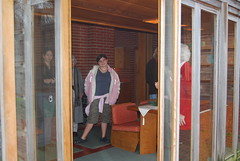 When I read the recent review of Loving Frank by Nancy Horan I was intrigued by the story of the affair between Mamah Borthwick Cheney and Frank Lloyd Wright. To be sure I've read a bit about the man and I was aware that he was a rather controversial figure. I had never heard about this part of his life.
When I read the recent review of Loving Frank by Nancy Horan I was intrigued by the story of the affair between Mamah Borthwick Cheney and Frank Lloyd Wright. To be sure I've read a bit about the man and I was aware that he was a rather controversial figure. I had never heard about this part of his life.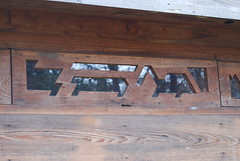 For those of you who are still unfamiliar, here are the broad strokes. In 1903 FLW built a bouse for the Cheneys in Oak Park, Illinois. Mamah and FLW quickly became involved in an affair and in 1909 they left their respective families (she had 2 children, he had 6) and ran away to Europe together. Although they returned to the US, they would never return to their families. The affair ended tragically in 1914.
For those of you who are still unfamiliar, here are the broad strokes. In 1903 FLW built a bouse for the Cheneys in Oak Park, Illinois. Mamah and FLW quickly became involved in an affair and in 1909 they left their respective families (she had 2 children, he had 6) and ran away to Europe together. Although they returned to the US, they would never return to their families. The affair ended tragically in 1914.Although the story is true, the book is a work of fiction. There simply isn't a great record of Mamah but Ms Horan has taken articles from the time, letters from Mamah, and what is known about FLW's life during that period and woven a wonderful story of their affair as it may have been. Mamah, a woman who was college educated and very interested in feminist issues of the day, is the focus of the novel. She was fluent in 6 languages and worked as a translator for Ellen Key, a Swedish feminist author.
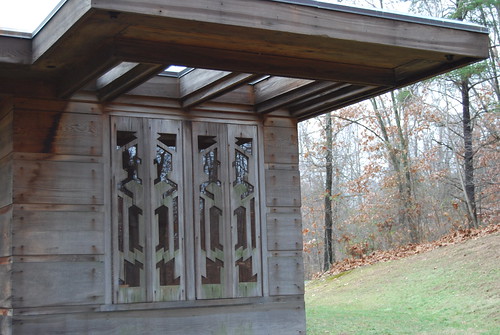
As I neared the end of the book late last week I felt that old sense of wanting to climb onto the pages and found that, in this rare instance, I almost could. There are 5 FLW in Virginia and Maryland but only one of them is open to the public. Thankfully, the Pope-Leighy house is only about 20 minutes from my house so I convinced DQ to experience it with me last Saturday.
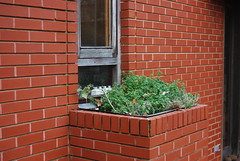 I am so glad that we went. To walk through one of FLW's structures is to marvel at the attention to the details and the way everything is so well thought out like the planter box which is placed right outside the kitchen window so that one could reach out while preparing dinner to clip herbs. Every space is utilized which would've been essential in a house like this because it's tiny. That was the first thing I noticed as we approached it. Inside the spaces compress in some spots like the entry which just a little over 6 feet high and the hall that is only 2 feet wide. Then you emerge into areas like the living room which feels expansive in comparison with 11 foot high ceilings and tall windows along both sides that bring the outside in.
I am so glad that we went. To walk through one of FLW's structures is to marvel at the attention to the details and the way everything is so well thought out like the planter box which is placed right outside the kitchen window so that one could reach out while preparing dinner to clip herbs. Every space is utilized which would've been essential in a house like this because it's tiny. That was the first thing I noticed as we approached it. Inside the spaces compress in some spots like the entry which just a little over 6 feet high and the hall that is only 2 feet wide. Then you emerge into areas like the living room which feels expansive in comparison with 11 foot high ceilings and tall windows along both sides that bring the outside in. The use of horizontal lines is hard to miss. The slots on the screw heads are all aranged horizontally, the cypress boards than make up the walls are arranged horizontally and, I don't know if you can see it from this picture but, the bricks use 2 shades of mortar, red for the vertical lines to make them blend in and white for the horizontal lines to accentuate them.
The use of horizontal lines is hard to miss. The slots on the screw heads are all aranged horizontally, the cypress boards than make up the walls are arranged horizontally and, I don't know if you can see it from this picture but, the bricks use 2 shades of mortar, red for the vertical lines to make them blend in and white for the horizontal lines to accentuate them.The wooden window screens were a favorite feature of DQ. (shhhh... she liked it but she told me she'd deny it if anyone asks) The cantilevers that FLW is so known for are in evidence throughout and I love the way they are used to extend the roof to make the house look bigger.
Today, the Pope-Leighy house is unusual but, back in 1940 when it was built, it must have been really unique. Walking through the house, I thought about how it must have appeared at the time to people accustomed to seeing more traditional homes. I wondered what kind of woman would choose a home that was so at odds with the norm. Nonconformity takes spirit and strength and that's what I see in the version of Mamah who lives on the pages of Loving Frank.
I can't wait to experience more of FLW's homes in person. As I told hubbo, we'll need to add a new vacation requirement - stops at yarn stores will now be joined by visits to FLW homes.
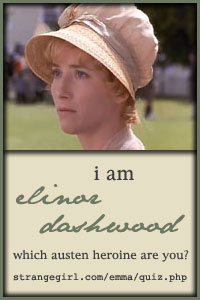



6 comments:
I have absolutely no idea what it's like to get absorbed into a book
--CursingMama (aka Stephanie Plum)
I don't know much at all about FLW so I really enjoyed reading this post. Thanks for the great photos, too.
There is a FLW house here in Utah...and many good yarn shops, too! Oh and me and my mountains as a bonus;-)
I'm about 1/2 done with that book right now and enjoying a ton. We're big fans of all the prairie school and arts & craft movement stuff of that era. There are even a few FLW houses around DH's hometown in Iowa so we've photographed a few from outside and toured one.
How very cool. you have so much there! And yes, I believe I AM still in one of my books: How to be disorganized, tired and confused!
When I first looked at the shots of the windows, I thought they were from the same FLW house I went to back in October up near Flaing Water. (I am drawing a blank on the name.) IThe Pope-Leighy house was my first FLW house. I love his designs.
Post a Comment